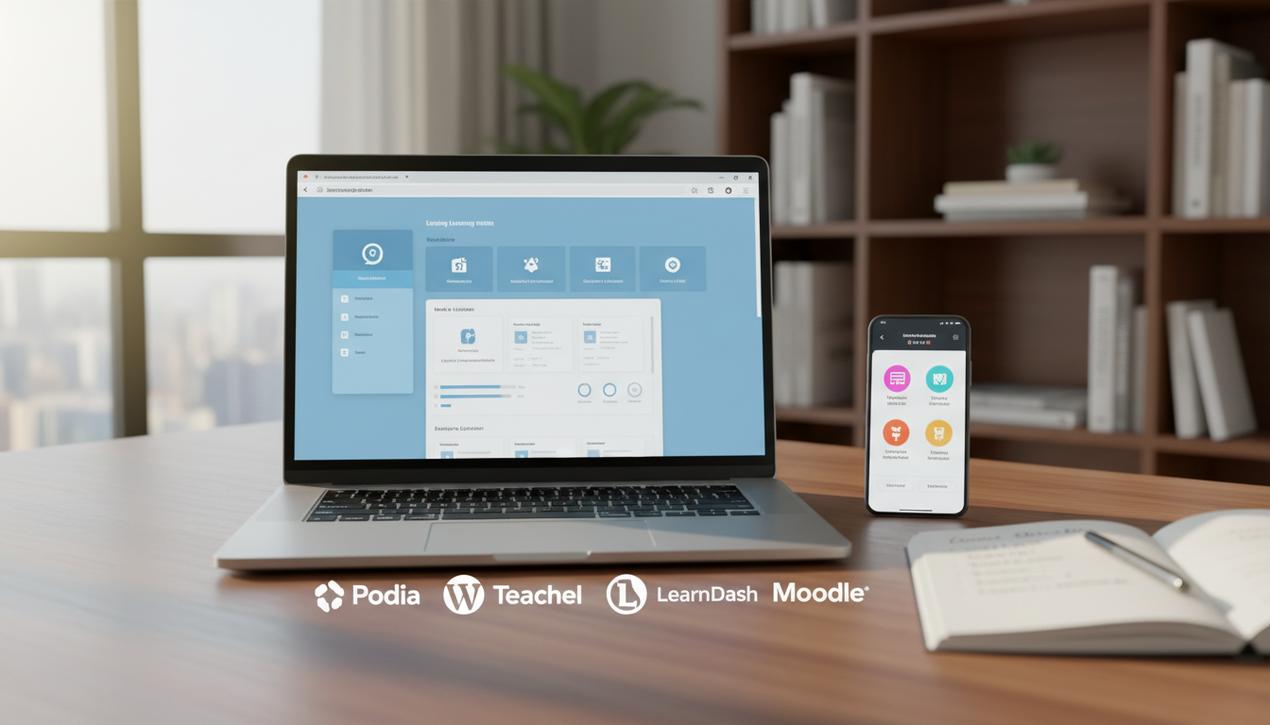A Complete Guide to Creating an Online Course Website


Transforming your expertise into a profitable venture is a powerful goal for countless professionals. With the global e-learning market projected to surpass $350 billion by the end of 2025, there has never been a more opportune time to create an online course website. This explosive growth, driven by a relentless demand for new skills, is unlocking unprecedented opportunities for individuals who want to share their knowledge. Launching your e-learning platform is far more than a technical task; it’s a full-fledged entrepreneurial journey. It requires a clear vision, a well-defined strategy, and the right set of tools to succeed. This comprehensive guide will walk you through seven essential steps, from validating your course idea to engaging your first students, helping you build a platform that is professional, engaging, and highly profitable.
Step 1: Validate Your Idea and Define Your Niche
Before you even consider design or technology, the success of your online course hinges on a solid foundation: a relevant idea and a clearly identified target audience. This initial phase is crucial to avoid the pitfall of creating a product that nobody wants or needs.
Analyze Your Unique Expertise
Start with an honest inventory of your knowledge and skills. List the areas where you have proven expertise, not just theoretical knowledge but practical, real-world experience. Ask yourself critical questions: What topics do colleagues or friends often ask for my advice on? What specific skill has helped me solve tangible problems in my career? The goal is to pinpoint a subject where your authority feels natural and where you can offer unique value that others cannot.
Conduct Thorough Market Research
Expertise alone is not enough if it doesn’t solve a problem people are willing to pay to fix. You must verify that an audience exists for the skills you offer. Immerse yourself in online communities related to your field: LinkedIn groups, specialized forums, Facebook groups, and platforms like Reddit or Quora. Look for recurring questions, common frustrations, and “pain points.” Use keyword research tools to gauge the search volume for the topics you’re considering. This investigation will help you refine your offer into a direct solution for an existing, pressing need.
Step 2: Design an Irresistible Course Curriculum
Once your niche is validated, it’s time to transform your expertise into a structured and compelling educational product. The quality of your curriculum and content is what will build your reputation and keep your students coming back for more.
Structure Your Learning Pathway
Break down your main topic into logical modules, and then divide each module into individual lessons. Each lesson should cover a specific, digestible point and conclude with a clear learning objective. Think about the student’s journey from beginner to expert. Start with the fundamentals before moving on to more advanced concepts. A clear, progressive structure helps maintain motivation and makes complex topics easier to grasp. A detailed outline of your entire course is an invaluable asset before you start production.
Incorporate Modern Learning Trends
The e-learning landscape in 2025 is heavily influenced by trends that prioritize engagement and flexibility. To make your course stand out, consider integrating these approaches:
- Micro-learning: Deliver content in short, focused lessons (typically 3-7 minutes long). This format is perfect for mobile learning and busy schedules, increasing completion rates.
- Gamification: Introduce game-like elements such as points, badges, leaderboards, and progress bars. This stimulates motivation and makes the learning process more enjoyable.
- Personalized Learning Paths: Offer students some flexibility in their learning journey, allowing them to focus on topics most relevant to their goals.
Step 3: Create High-Quality and Diverse Content
With a solid curriculum in place, the next step is producing the actual course materials. High production quality builds trust and directly impacts the perceived value of your training. While video is king in online education, a multi-format approach caters to different learning styles.
Mastering Video Production
Video is the most engaging format for online courses. You don’t need a Hollywood studio, but clear audio and good lighting are non-negotiable. Invest in a quality microphone and basic lighting kit. Your video content can include:
- Talking-head videos: You speaking directly to the camera to explain concepts and build a personal connection.
- Screencasts: Screen recordings are perfect for software tutorials or demonstrating processes on a computer.
- Presentations with voiceover: A slide deck with your narration, ideal for structured, data-heavy content.
Diversify Your Content Formats
Supplement your videos with a variety of other resources to enrich the learning experience. These materials also serve as valuable takeaways for your students.
- Downloadable PDFs: Checklists, workbooks, templates, and summaries that students can keep.
- Quizzes and Assignments: Practical exercises that allow students to apply what they’ve learned and test their knowledge.
- Live Q&A Sessions: Webinars or live streams to foster interaction and build a community around your course.
Step 4: Choose the Right Technology Platform
The technology that hosts and delivers your course is the engine of your online business. This is your Learning Management System (LMS). The right choice depends on your budget, technical comfort level, and long-term goals.
All-in-One Hosted Platforms
Platforms like Teachable, Thinkific, and Kajabi are excellent for beginners. They handle everything from video hosting and payment processing to sales page creation and email marketing. They are designed to be user-friendly, requiring no technical skills, but operate on a monthly subscription model.
WordPress Plugin Solutions
If you already have a WordPress site or desire maximum control and flexibility, plugins like LearnDash or LifterLMS can transform your website into a powerful e-learning platform. This option provides complete ownership and customization but requires you to manage your own hosting, security, and technical setup.
Open-Source Platforms
For those with technical expertise, solutions like Moodle offer immense power and are free to use. Moodle is the standard in academic institutions but demands significant technical knowledge for installation, configuration, and ongoing maintenance on a robust server.
Step 5: Build a Professional and Convincing Website
Your website is your digital storefront. It must do more than just host your course content; it must inspire trust and persuade visitors to become paying students. A poorly designed or confusing interface can undermine the perceived quality of even the best course.
Focus on Design and User Experience (UX)
Choose a clean, professional design that is easy to navigate. Ensure your site is fully responsive, meaning it looks and works great on all devices, including desktops, tablets, and smartphones. The user journey, often planned with a detailed website mockup, should be seamless, from discovering your course offer to enrolling and accessing the material.
Create Essential Pages
An effective online course website needs several key pages:
- A compelling Homepage that clearly communicates your value proposition.
- A detailed Course Sales Page that outlines the curriculum, learning objectives, target audience, and includes testimonials.
- An About Page to tell your story, build credibility, and connect with your audience on a personal level.
- A Contact Page so potential students can easily ask questions.
Step 6: Define Your Pricing Strategy and Business Model
How will you monetize your expertise? Your business model is a strategic decision that should align with your content, your audience’s expectations, and your income goals.
One-Time Purchase
Students pay a single fee for lifetime access to a specific course. This model is simple, straightforward, and works well for courses that teach a distinct, finite skill. It’s an excellent starting point, especially if your course creation is a side business.
Subscription or Membership Model
Customers pay a recurring fee (monthly or annually) for access to your entire library of courses, a community, and regularly updated content. This model generates predictable revenue but requires a continuous effort to produce new content to justify the subscription and reduce churn.
Hybrid and Tiered Models
Combine approaches for greater flexibility. You might offer a free introductory course to generate leads (a freemium model), then sell advanced courses as one-time purchases. Alternatively, you could offer different pricing tiers for the same course, with higher tiers including extra benefits like personal coaching or community access.
Step 7: Launch, Market, and Foster a Community
Creating an amazing online course is only half the battle. Without an effective marketing strategy, no one will know it exists. Now it’s time to attract your first students and build for the long term.
Leverage Content Marketing and SEO
Start a blog or YouTube channel to share free, valuable content related to your topic. This positions you as an expert, improves your website’s search engine optimization (SEO), and attracts qualified traffic. Write articles and create videos that answer the common questions of your target audience.
Use Email Marketing and Social Media
Build an email list from day one by offering a valuable freebie (like an ebook or a checklist). Email is one of the most effective channels for building a relationship with your audience and promoting your course launches. Identify the social media platforms where your audience spends their time, like LinkedIn where you can learn from top industry influencers, and engage with them authentically.
Build a Learning Community
Go beyond a simple transaction by creating a space for your students to connect, such as a private Facebook group, a Slack channel, or a dedicated forum. An active community fosters peer-to-peer support, increases the perceived value of your course, and turns your students into loyal brand ambassadors.
Launching an online course website is an ambitious project that blends pedagogical expertise, technical skills, and an entrepreneurial mindset. By following these steps methodically, you position yourself for success—building a robust platform, attracting a dedicated audience, and generating revenue by sharing your passion. The e-learning market is booming and ready for experts who are prepared to teach in a professional and engaging way.




